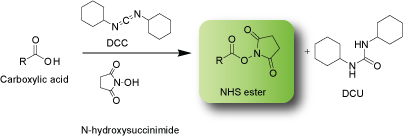Small Molecule Activation
This is an intermediate step required for coupling a small molecule to a biopolymer. Some small molecules are commercially available in an activate form. For non-active molecules, we can either convert them to an active form first or let them react directly with a biopolymer using active coupling reagents.
CellMosaic uses these processes exclusively for supporting our custom Biopolymer Labeling and Biopolymer Conjugation.
Example 1: Preparation of an active ester of carboxylate (-COOH) compound for reaction with amine-containing biopolymers.
In situ activation of carboxylic acid groups using dicyclohexylcarbodiimide (DCC) and N-hydroxyl succinimide (NHS). After filtration of the byproduct dicyclohexylurea (DCU), the activated NHS-ester will be used directly for biopolymer labeling.

Scheme 1. NHS ester formation using DCC coupling
References:
1. Sheehan, J. C.; Hess, G. P. A new method of forming peptide bonds. J. Am. Chem. Soc. 1955, 77, 1067-1068.
2. Staros, J. V.; Lee, W. T. Conrad DH. Membrane-impermeant cross-linking reagents: application to the study of the cell surface receptor for IgE. Methods Enzymol. 1987;150:503-12. PMID: 2963194
3. Anjaneyulu, P. S.; Staros, J. V. Reactions of N-hydroxysulfosuccinimide active esters. Int. J. Pept. Protein Res. 1987 Jul;30(1):117-24. PMID: 3667072
